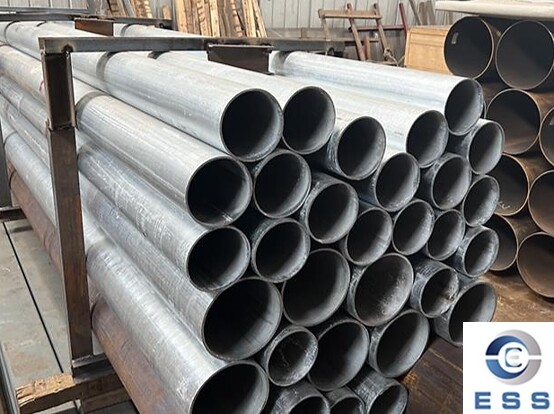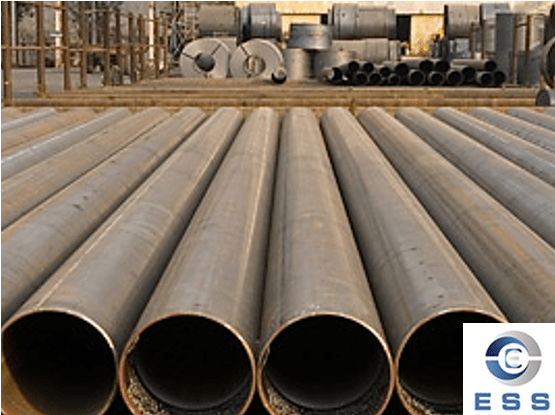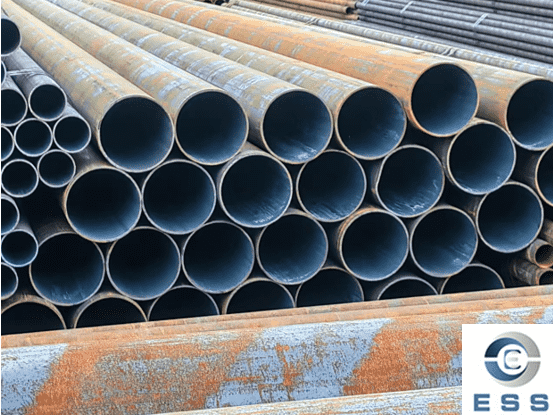
EN 10210 is part of the European standard
that specifies the technical delivery conditions for hot-formed welded
structural hollow
section steel pipes. Specifically, the EN 10210 standard covers structural
hollow seamless
steel pipe made of non-alloy and fine-grained steel materials for
hot-formed welding. Due to the hot rolling manufacturing process, EN 10210 may
have some roughness and unevenness on the surface of the pipe due to the high
temperature and rolling force during the hot rolling process. These seamless
steel pipes are generally used in building structures, bridges, machinery
manufacturing, equipment manufacturing and other engineering applications.
EN 10210 standard
1. Material requirements
The material requirements of steel pipes
are strict, covering the chemical composition, physical properties, etc. of
different alloy steels and non-alloy steels.
2. Production process requirements
The hot rolling process of steel pipes is
clearly specified, especially the requirements for the cooling rate,
dimensional accuracy, etc. of steel pipes during the production process.
3. Inspection and quality control
Including quality inspection standards such
as the size, wall thickness, and mechanical properties of steel pipes to ensure
that the steel pipes meet the relevant performance requirements.
Classification of EN 10210
The EN 10210 standard divides hot-rolled
steel pipes into two categories:
1. Non-alloy steel pipes
Used in ordinary construction and
structural engineering, such as industrial facilities, storage facilities, etc.
2. Alloy steel pipes
Due to the addition of alloy elements, this
type of steel pipe has higher strength, corrosion resistance and better high
temperature resistance, and is suitable for more demanding environments, such
as high temperature and high pressure energy facilities.
EN 10210 standard applicable size range
Diameter Typical diameters are 21.3mm,
26.9mm, 33.7mm, 42.4mm, etc.
Common wall thicknesses are 2.3mm, 2.6mm,
3.2mm, 4.0mm, etc.
The following table shows a part of the
standard sizes of EN 10210 hollow round
tubes:
|
Outer diameter D (mm)
|
Thickness T (mm)
|
Mass per unit length M (kg/m)
|
Cross-sectional area A (cm²)
|
Moment of inertia I (cm⁴)
|
Radius of gyration i (cm)
|
Elastic modulus Wel (cm³)
|
Plastic modulus Wpl (cm³)
|
Torsion constant It (cm⁴)
|
Torsion modulus constant Ct (cm³)
|
Surface area per meter As (m²/m)
|
Standard length per ton (m)
|
|
21.3
|
2.3
|
1.08
|
1.37
|
0.629
|
0.677
|
0.590
|
0.834
|
1.26
|
1.18
|
0.0669
|
928
|
|
21.3
|
2.6
|
1.20
|
1.53
|
0.681
|
0.668
|
0.639
|
0.915
|
1.36
|
1.28
|
0.0669
|
834
|
|
21.3
|
3.2
|
1.43
|
1.82
|
0.768
|
0.650
|
0.722
|
1.06
|
1.54
|
1.44
|
0.0669
|
700
|
|
26.9
|
2.3
|
1.40
|
1.78
|
1.36
|
0.874
|
1.01
|
1.40
|
2.71
|
2.02
|
0.0845
|
717
|
|
26.9
|
2.6
|
1.56
|
1.98
|
1.48
|
0.864
|
1.10
|
1.54
|
2.96
|
2.20
|
0.0845
|
642
|
|
26.9
|
3.2
|
1.87
|
2.38
|
1.70
|
0.846
|
1.27
|
1.81
|
3.41
|
2.53
|
0.0845
|
535
|
|
33.7
|
2.6
|
1.99
|
2.54
|
3.09
|
1.10
|
1.84
|
2.52
|
6.19
|
3.67
|
0.106
|
501
|
|
33.7
|
3.2
|
2.41
|
3.07
|
3.60
|
1.08
|
2.14
|
2.99
|
7.21
|
4.28
|
0.106
|
415
|
|
33.7
|
4.0
|
2.93
|
3.73
|
4.19
|
1.06
|
2.49
|
3.55
|
8.38
|
4.97
|
0.106
|
341
|
|
42.4
|
2.6
|
2.55
|
3.25
|
6.46
|
1.41
|
3.05
|
4.12
|
12.9
|
6.10
|
0.133
|
392
|
|
42.4
|
3.2
|
3.09
|
3.94
|
7.62
|
1.39
|
3.59
|
4.93
|
15.2
|
7.19
|
0.133
|
323
|
|
42.4
|
4.0
|
3.79
|
4.83
|
8.99
|
1.36
|
4.24
|
5.92
|
18.0
|
8.48
|
0.133
|
264
|
|
48.3
|
2.6
|
2.93
|
3.73
|
9.78
|
1.62
|
4.05
|
5.44
|
19.6
|
8.10
|
0.152
|
341
|
|
48.3
|
3.2
|
3.56
|
4.53
|
11.6
|
1.60
|
4.80
|
6.52
|
23.2
|
9.59
|
0.152
|
281
|
|
48.3
|
4.0
|
4.37
|
5.57
|
13.8
|
1.57
|
5.70
|
7.87
|
27.5
|
11.4
|
0.152
|
229
|
|
48.3
|
5.0
|
5.34
|
6.80
|
16.2
|
1.54
|
6.69
|
9.42
|
32.3
|
13.4
|
0.152
|
187
|
|
60.3
|
2.6
|
3.70
|
4.71
|
19.7
|
2.04
|
6.52
|
8.66
|
39.3
|
13.0
|
0.189
|
270
|
|
60.3
|
3.2
|
4.51
|
5.74
|
23.5
|
2.02
|
7.78
|
10.4
|
46.9
|
15.6
|
0.189
|
222
|
|
60.3
|
4.0
|
5.55
|
7.07
|
28.2
|
2.00
|
9.34
|
12.7
|
56.3
|
18.7
|
0.189
|
180
|
|
60.3
|
5.0
|
6.82
|
8.69
|
33.5
|
1.96
|
11.1
|
15.3
|
67.0
|
22.2
|
0.189
|
147
|
|
76.1
|
2.6
|
4.71
|
6.00
|
40.6
|
2.60
|
10.7
|
14.1
|
81.2
|
21.3
|
0.239
|
212
|
|
76.1
|
3.2
|
5.75
|
7.33
|
48.8
|
2.58
|
12.8
|
17.0
|
97.6
|
25.6
|
0.239
|
174
|
|
76.1
|
4.0
|
7.11
|
9.06
|
59.1
|
2.55
|
15.5
|
20.8
|
118
|
31.0
|
0.239
|
141
|
|
76.1
|
5.0
|
8.77
|
11.2
|
70.9
|
2.52
|
18.6
|
25.3
|
142
|
37.3
|
0.239
|
114
|
|
88.9
|
3.2
|
6.76
|
8.62
|
79.2
|
3.03
|
17.8
|
23.5
|
158
|
35.6
|
0.279
|
148
|
|
88.9
|
4.0
|
8.38
|
10.7
|
96.3
|
3.00
|
21.7
|
28.9
|
193
|
43.3
|
0.279
|
119
|
|
88.9
|
5.0
|
10.3
|
13.2
|
116
|
2.97
|
26.2
|
35.2
|
233
|
52.4
|
0.279
|
96.7
|
|
88.9
|
6.3
|
12.8
|
16.3
|
140
|
2.93
|
31.5
|
43.1
|
280
|
63.1
|
0.279
|
77.9
|
|
101.6
|
3.2
|
7.77
|
9.89
|
120
|
3.48
|
23.6
|
31.0
|
240
|
47.2
|
0.319
|
129
|
|
101.6
|
4.0
|
9.63
|
12.3
|
146
|
3.45
|
28.8
|
38.1
|
293
|
57.6
|
0.319
|
104
|
|
101.6
|
5.0
|
11.9
|
15.2
|
177
|
3.42
|
34.9
|
46.7
|
355
|
69.9
|
0.319
|
84.0
|
|
101.6
|
6.3
|
14.8
|
18.9
|
215
|
3.38
|
42.3
|
57.3
|
430
|
84.7
|
0.319
|
67.5
|
|
101.6
|
8.0
|
18.5
|
23.5
|
260
|
3.32
|
51.1
|
70.3
|
519
|
102
|
0.319
|
54.2
|
|
101.6
|
10.0
|
22.6
|
28.8
|
305
|
3.26
|
60.1
|
84.2
|
611
|
120
|
0.319
|
44.3
|
|
114.3
|
3.2
|
8.77
|
11.2
|
172
|
3.93
|
30.2
|
39.5
|
345
|
60.4
|
0.359
|
114
|
EN 10210 seamless steel pipe:Chemical composition requirements
The chemical composition of EN 10210
seamless steel pipes includes carbon (C), silicon (Si), manganese (Mn),
phosphorus (P), sulfur (S), etc. The carbon content is generally required to be
no more than 0.22%, the silicon content is no more than 0.55%, the manganese
content is no more than 1.6%, the phosphorus content is no more than 0.025%,
and the sulfur content is no more than 0.025%. EN 10210 seamless pipes have
excellent machinability and can meet appropriate strength in occasions such as OCTG pipe. .
EN 10210 seamless steel pipe:Tolerance requirements
The EN 10210 standard has clear provisions
for the outer diameter, wall thickness and other dimensions of seamless steel
pipes. The allowable tolerances of outer diameter and wall thickness vary
according to different size ranges. For example, for steel pipes with an outer
diameter within a certain range, the outer diameter tolerance may be around
plus or minus 1%, and the wall thickness tolerance also has a corresponding
strict range, which ensures the dimensional accuracy of the steel pipe to meet
the requirements of various engineering applications. For example, in
application scenarios such as pipeline connection, accurate dimensions are the
key to ensuring the sealing and stability of the pipeline system.
EN 10210 seamless steel pipe:Surface quality requirements
The surface of the steel pipe should be
free of harmful defects, such as cracks, folds, delamination, etc. Slight
surface roughness and some surface defects that do not affect the performance,
such as small dents, etc., are allowed, but the depth and range of these
defects are also limited. Good surface quality is important for the corrosion
resistance and appearance of steel pipes, especially in some applications with
high surface quality requirements, such as steel pipes for architectural
decoration or carbon
steel pipe used in corrosive environments.
EN 10210 seamless steel pipe:Application scope
Seamless steel pipes that meet EN 10210
standards are widely used in the field of building structures, such as building
frames, scaffolding, etc.; in mechanical manufacturing, they can be used to
manufacture some mechanical parts that do not have extremely high requirements
for strength and precision, such as ordinary conveying equipment, support
structures for small machinery, etc.; in pipeline engineering, they are used to
transport some low-pressure fluid media, such as low-pressure water, air and
other pipeline systems.
Read more: EN 10220 vs EN 10210













 Eastern Steel Manufacturing Co.,Ltd not only improve product production and sales services, but also provide additional value-added services. As long as you need, we can complete your specific needs together.
Eastern Steel Manufacturing Co.,Ltd not only improve product production and sales services, but also provide additional value-added services. As long as you need, we can complete your specific needs together.










